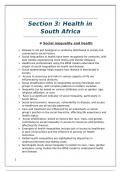Section 3: Health in
South Africa
Social inequality and health
Disease is not just biological or randomly distributed in society but
connected to social factors.
Social inequalities in health have been recognised for centuries, with
poor people experiencing more illness and shorter lifespans.
Healthcare professionals using the BPSE model understand the
impact of social inequalities on health and disease.
Social epidemiology helps explain how disease is distributed in
society.
Access to resources and risks in various aspects of life are
influenced by social divisions.
Social stratification refers to inequalities among individuals and
groups in society, with complex patterns in modern societies.
Inequality can be based on various attributes such as gender, age,
religious affiliation, or race.
Race is a significant indicator of social inequality, particularly in
South Africa
Social and economic resources, vulnerability to disease, and access
to healthcare are all socially patterned.
Care and treatment are influenced by an individual's or social
group's position in the social hierarchy, affecting life expectancy and
health status.
Social stratification, based on factors like race, class, and gender,
contributes to social inequality in access to resources and facilities,
affecting life chances.
Examples of health inequalities include lack of access to healthcare
in poor communities and the influence of poverty on health
outcomes.
Global health inequalities are highlighted by disparities in
undernourishment and obesity rates.
Sociologists study social inequality in relation to race, class, gender,
and place, using models like the BPSE model to understand health
and disease.
1
, Intersectionality considers the complex interplay between disease
and social identities.
2





